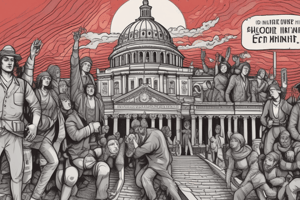Podcast
Questions and Answers
What is the primary characteristic of sexism as defined by Swim and Hyers (2009)?
What is the primary characteristic of sexism as defined by Swim and Hyers (2009)?
- Promoting gender-neutral language
- Supporting equal status of women and men
- Reflecting negative evaluations of individuals based on their gender (correct)
- Encouraging gender-based stereotypes
At which stage of sexism manifestation does the perpetrator misuse power, authority, or other resources to induce threat or fear?
At which stage of sexism manifestation does the perpetrator misuse power, authority, or other resources to induce threat or fear?
- Sexual violence
- Forced sexual behaviors
- Acts of sexual harassment (correct)
- Verbal and nonverbal manifestation of sexism
What is the primary consequence of rape on the victim's psyche, according to scholarly discussions?
What is the primary consequence of rape on the victim's psyche, according to scholarly discussions?
- Feelings of empowerment and resistance
- Fears of face-to-face victimization
- Loss of self-esteem and confidence
- Feelings of shame, fear, and helplessness (correct)
What is the ultimate form of violence in the context of sexual abuse, as described in the text?
What is the ultimate form of violence in the context of sexual abuse, as described in the text?
What is the primary objective of the perpetrator in the act of rape, according to the text?
What is the primary objective of the perpetrator in the act of rape, according to the text?
What is the definition of rape, according to Holstrom and Burges (1975)?
What is the definition of rape, according to Holstrom and Burges (1975)?
What is the broader definition of a victim?
What is the broader definition of a victim?
According to the UN Declaration of Basic Principles of Justice for Victims of Crime and Abuse of Power, what type of victims are categorized as indirect victims?
According to the UN Declaration of Basic Principles of Justice for Victims of Crime and Abuse of Power, what type of victims are categorized as indirect victims?
What is the first stage of sexual abuse according to the text?
What is the first stage of sexual abuse according to the text?
What is the result of stereotypes in the context of sexual abuse?
What is the result of stereotypes in the context of sexual abuse?
What is an example of a stereotype mentioned in the text?
What is an example of a stereotype mentioned in the text?
What is the relation between stereotypes and sexist attitudes in the context of sexual abuse?
What is the relation between stereotypes and sexist attitudes in the context of sexual abuse?
Flashcards are hidden until you start studying
Study Notes
Definition of a Victim
- A victim is a person whose right or good has been violated by committing a crime or violating international human rights norms.
- In a broader sense, victims can also include organizations and social groups whose rights or goods have been violated.
Categories of Victims
- Victims of criminal acts
- Victims of power misuse
- Indirect victims (family members, people who helped victims, etc.)
Stages of Sexual Abuse
Stereotypes
- Sexual abuse originates with stereotypes that are a collective inheritance of any society or community.
- These stereotypes are intergenerational and communicated through day-to-day conversations via various agencies of socialization.
Sexist Attitude
- Based on stereotypes, an individual develops a sense of superiority or inferiority.
- Examples of sexist attitudes include beliefs that women are bad drivers, men are good in certain skills, and gays have HIV.
Verbal and Nonverbal Manifestation of Sexism
- Sexism is defined as individuals' attitudes, beliefs, behaviors, and organizational, institutional, or cultural practices that reflect negative evaluations of individuals based on their gender or support unequal status of women and men.
- This stage involves discrimination or prejudices that an individual covertly learns, manifesting in various forms depending on geographical location and sociocultural practices.
Acts of Sexual Harassment
- This stage involves the misuse of power, authority, or other resources to induce threat or fear or to trade or bargain with the victim.
- The manifestation at this stage may progress to physically approaching the victim and exerting pressure using nonsexual behaviors.
Forced Sexual Behaviors
- The perpetrator misinterprets the victim's emotional state or verbal or behavioral cues, leading to the execution of sexual behaviors including touching, fondling, rubbing, or rape.
Sexual Violence
- This stage involves forced sexual behaviors that may include violence, leading to intentional murder or inflicting violence to the extent that the victim dies.
Recognizing the Suffering: Rape
- Rape is an act of forced sexual relation, followed by violence, and is the most brutal form of sexual abuse.
- Rape includes the use of physical force, threats, torture, and violent sexual acts, which are unwilling by the victim.
Trauma After Rape
- The strongest traumas for women are probably violence and sexual assault and rape.
- Rape is forced, violent sexual penetration against the victim's will, and without the victim's consent.
Studying That Suits You
Use AI to generate personalized quizzes and flashcards to suit your learning preferences.



